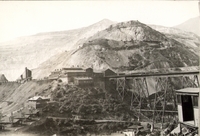GROWING UP IN BINGHAM CANYON

GROWING UP IN BINGHAM CANYON – By John J. Creedon First published in the Bingham Bulletin 14 Oct 1960—————
I shall always be grateful for the opportunity of growing up in Bingham, truly a melting pot of humanity. It is true that most mining towns were largely made up of different races and creeds, but here we were so compact. We all used the same schools, the same churches. We went to the same theaters and the same entertainments. We even used the same street. (Of course we only had one to begin with.)
This closeness produced a tolerance and understanding between people from different countries and places, that is not present in larger cities.
Two of our native daughters, who have made their mark in their chosen profession, Ivy Baker Priest and Dr. Lenore Richards have told me on several occasions that the background and environment of Bingham was an important part in their relations with the public and gave them a broader understanding of the many problems that confront all of us from time to time.
I remember well of my first friends-boys and girls of many nationalities, Swedes, Finns, Greeks, Italians, Japanese, Jewish, Austrians, Slavonians, English and Irish. We had no racial problems as I can recall. We all played together and we even picked up some of the languages of our friends.
Most of the Austrians and Slavonians and a good portion of the Italians settled in Highland Boy; the Greeks, Japanese and Englishmen in Upper Bingham, Carr Fork was the home of the Swedes and Finns, and Upper Main had the bulk of the Italians.
It was considered unwise in those early days to venture into new territory alone. You would probably run into one of the gangs in that particular neighborhood and get initiated. This happened to my brother, Dan, the first day we were in Bingham. Mother sent him down town to the Bingham Merc. for a piece of stove pipe. One hour later he returned with the black stove pipe and a pair of eyes to match. He had been initiated into the Carr Fork gang.
Mother ran a boarding house for the railroad men and took care of the B&G dormitory too. Life was never dull in a boarding house in those days, with boomer railroad men and miners continually on the move. I was fascinated by the tales of some of these men and would take in every word they would say. They had been around, or at least they talked like it. Some had sailed the seven seas, worked on every railroad in the country, or worked in many of the famous mining camps in the West.
Tex Marshall, a tall lean Texan was one of my favorites. He would talk in Spanish and throw fits for my benefit. He remained a good friend of mine until his death last year. “Society” Brown was another character I remember so vividly. He was a dandy for sure. Wore a derby hat and carried a cane. He worked at the B&G depot. One Christmas he paid my mother his board bill with twenty-five one dollar bills, each tied with a pretty red ribbon and in a fancy jewel case.
Another character I remember was a pompous old gentleman, named Howard, but called General Noga, my mother. She said he remined her of Noga, the hero of the Russian-Japanese war. He disliked children, and especially me. I was bribed to slam the door whenever I came in the house during dinner hour, by Tex and some of the other men as this displeased him very much. I made quite a bit of money, as I was most cooperative in making life miserable for him.
My neighbors at the B&G were all Japanese. The section hands lived in the house across from ours. I made many good friends among these people and one in particular, K. Seow. He was a dear friend to my family for many years and when my father died in 1926, Seow cried as hard and as long as any of us. He called him Poppa and told the railroad men, he was Irish, because Mr. Mike was Irish and his Poppa. When I lost my mother and my brothers, Seow was one of the first there to try and comfort me.
They ate at a long table and the main food was rice. They had a sauce that came in wooden tubs, that was poured on the rice and fish to supplement the diet of rice. I guess every family in town had one of these tubs at one time or another with flowers or plants growing in them.
New Years was always a big day at the Japanese camp. They would pound out a paste of rice in a hollow tree trunk, using a big wooden mallet and little cakes of this rice would be offered up to Budda. Each man had a little shrine to Budda near his bed. They slept in a large room and each man had his section separated with a curtain. The huge table in the dining room would be heaped with all kinds of food-lobster, crab, shrimp, turkey, roasts of meat and fruit of all kinds and plenty to Sake to drink. Everyone was welcome. Some of the guests, unfamiliar with that potent drink, Sake, would have a tough time making the stairs to the dormitory or the tram.
